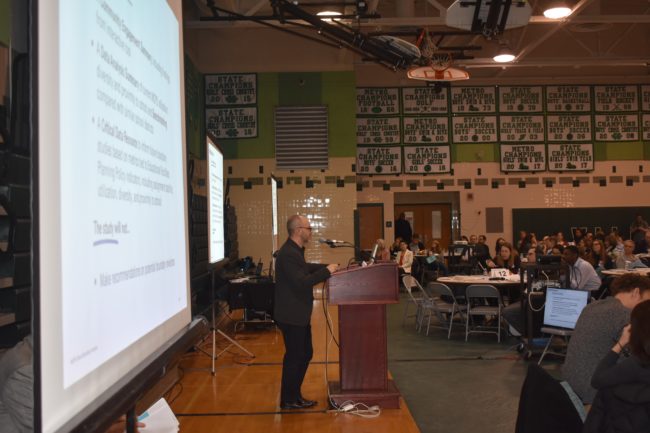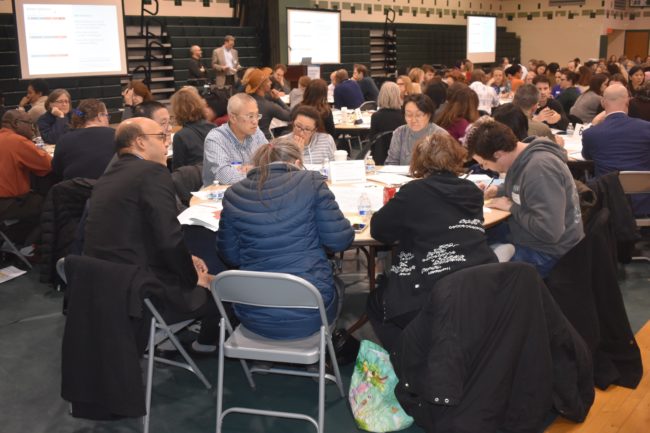Montgomery County Public Schools officials said they were pleased with the decorum of a meeting about an ongoing review of school boundaries that they feared might be unruly.
On Thursday night, approximately 650 people flocked to Walter Johnson High School in Bethesda for the sixth and final community meeting for the first phase of the countywide boundary analysis. The review has sparked tension that has occasionally boiled over at previous meetings.
“Yeah, it gets a little tense at times but we understand where that’s coming from, because people are very passionate about this topic,” MCPS spokeswoman Gboyinde Onijala said after the meeting. “The challenge is there’s so many questions and so little time, at least in this first phase. But what we want people to know is this isn’t the end of the work. It’s just phase one and there will be more opportunities for the community to offer their feedback and share their insights.”
The consultants hired to do the project, WXY Architecture + Urban Design, based in New York, are expected to release an interim report about the analysis next month. It will include a summary of data and findings they have gathered so far.
Then, the second phase of the project will kick off, with more community meetings to present and explain the data. Also in the second phase, consultants are expected to unveil an “interactive mapping tool” that will allow community members to visualize what potential changes might look like and how those changes might affect a school.
The first-of-its-kind boundary analysis was authorized by the Montgomery County Board of Education in January 2019. The purpose was to analyze boundaries and their impact on schools’ capacity, student body demographics and students’ ability to walk to school.
The $475,000 study has drawn a sharp divide between some community members with differing opinions.

Onijala said school district officials were anxious about the Walter Johnson meeting on Thursday because they had seen calls to action on social media from both sides of the debate. In some posts, community members were strategizing about how to ensure their voices were heard and drown out others, Onijala said.
But during the meeting, WXY representatives gave their presentation and answered followup questions. Small-group conversations appeared productive.
To accommodate the large crowd, attendees were divided among two rooms. Half were in the school’s gym and half were in the cafeteria, where an identical presentation was given.
The last half-hour of the meeting was reserved for a question-and-answer session, during which audience members often asked pointed questions about the project’s goals and the school board’s transparency throughout the process.
“Sometimes questions were sharp and that’s OK,” project consultant Theo Brown said. “People ought to be sharp if they have concerns. We want the feedback.”
In the gym, one person emphasized the importance of any future boundary changes taking into account how they might affect a school’s Title 1 status, a designation given to schools with a high percentage of students eligible for free and reduced-priced meals. Title 1 schools receive additional state funding.
Another person suggested MCPS created a “lottery option” in which families with students in schools that are over capacity could apply for a nearby school that has room for more students.
Several community members emphasized the need for more transparency from MCPS as the process moves forward.
“My question is: When is the board going to take this information, make recommendations and truly involve the community in the process and not kind of push it through quickly,” a parent, who did not identify himself, asked. “There needs to be a fair process after the data is presented.”
MCPS Chief Financial Officer Andy Zuckerman responded that, to his knowledge, the school board does not intend to do a countywide redistricting. Instead, he said, the WXY report will become a “reference document” as the board undertakes routine boundary studies that generally occur after a school is built or an addition is built onto an existing school.
Another community member questioned how the boundary analysis, and any changes that happen as a result, will improve students’ academic performance.
Zuckerman said the analysis is to gather data, not to analyze any specific boundary changes. Rather, it is to view schools largely through a “facility and utilization lens.”
“We also don’t want students in overcrowded schools, so the question is how to best relieve overutilization, and that’s what drives a lot of our decision making from a facilities perspective,” Zuckerman said. “That’s the tangible benefit. How that translates to student achievement is a different story. … There are factors that are not emphasized in this study because of the policies we’re using to guide this study.”
Some of the same topics were raised during the question-and-answer session in the cafeteria, including questions and criticism about transparency and the intent of the review.
Some participants asked about plans to include students’ voices in the process, how a child’s “nearest” school is determined, and how MCPS and its consultant are addressing public misinformation. Questions drew varying amounts of applause.
One woman said people are speaking out in protest about the analysis not because they are afraid of change or are confused, but because they have lost confidence in Superintendent Jack Smith and the MCPS staff.

One mother said collecting data is great, but there needs to be more of a focus on the social and health ramifications of moving children out of their neighborhoods to go to school elsewhere. She said children will be tired from longer bus rides and their mental health will suffer.
Another participant said the boundary analysis is a waste of money that isn’t addressing key issues related to children, such as how to cut drug use, adding: “These studies need to stop.”
Brian Orgen of Bethesda, who lives in the Walt Whitman High School cluster, asked what problems MCPS and consultants are trying to solve and how the data would be used. Or, he wondered, is it just an intellectual exercise?
Orgen said in an interview later that questions to study should be clear first, before an attempt to gather data to answer them.
Moira Ratchford, who lives in Wheaton and has a daughter who attends Albert Einstein High School, said during the question-and-answer period that such a long time has passed since the boundaries were evaluated, and so much has changed in the county, the analysis is needed.
The alternative, she said, might be “consigning us to ignorance.”
Managing Editor Andrew Schotz contributed to this story
Caitlynn Peetz can be reached at caitlynn.peetz@moco360.media



